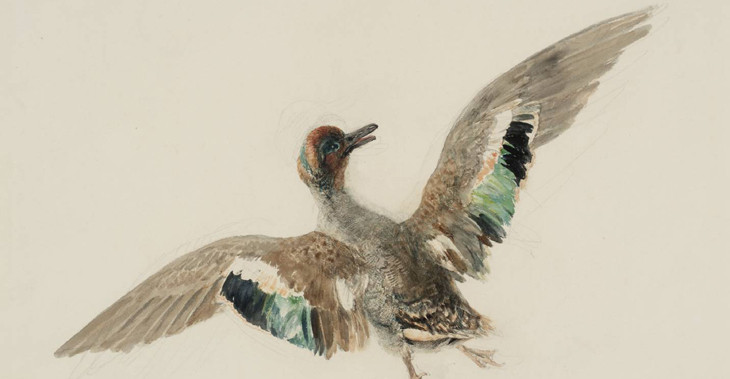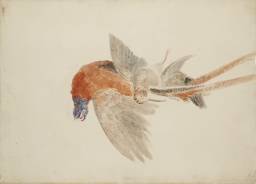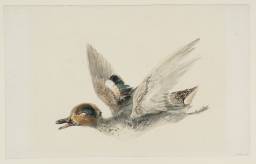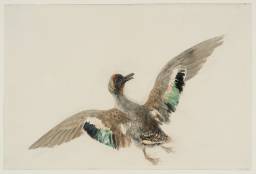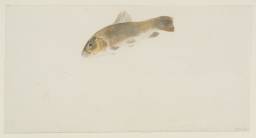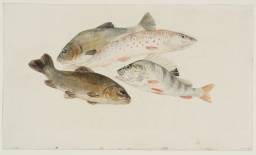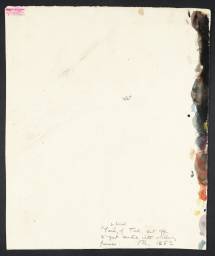From the entry
The critic and watercolourist John Ruskin praised the ‘ultimate refinements’ of colour in Turner’s natural history drawings, highlighting ‘the grey down of the birds and the subdued iridescences of the fish’. The colour studies in this section include some of those that Ruskin most admired, and are generally thought to date from around the same time as Turner’s bird illustrations for a particular natural history project, the Ornithological Collection. The five-volume Ornithological Collection wascompiled at Farnley Hall, the Yorkshire home of Turner’s friend and patron, Walter Fawkes, who likely oversaw the project (see David Hill’s ‘Farnley and Yorkshire c.1808–24’ section in the present catalogue). Fawkes’s passion for natural history was reflected not only by this considerable undertaking, but also by the reported introduction of zebra, wild hog and deer onto his land and the writing of a four volume ...
D25461–D25464, D25481, D25482, D25520
Turner Bequest CCLXIII 338, 339, 340, 341, 358, 359, CCLXIII a 5
Turner Bequest CCLXIII 338, 339, 340, 341, 358, 359, CCLXIII a 5
References
The critic and watercolourist John Ruskin praised the ‘ultimate refinements’ of colour in Turner’s natural history drawings, highlighting ‘the grey down of the birds and the subdued iridescences of the fish’.1 The colour studies in this section include some of those that Ruskin most admired, and are generally thought to date from around the same time as Turner’s bird illustrations for a particular natural history project, the Ornithological Collection.
The five-volume Ornithological Collection wascompiled at Farnley Hall, the Yorkshire home of Turner’s friend and patron, Walter Fawkes, who likely oversaw the project (see David Hill’s ‘Farnley and Yorkshire c.1808–24’ section in the present catalogue). Fawkes’s passion for natural history was reflected not only by this considerable undertaking, but also by the reported introduction of zebra, wild hog and deer onto his land and the writing of a four volume Synopsis of Natural History, which was published in 1823.2 The volumes of the Ornithological Collection were filled with feathers and bird illustrations, some taken from books – notably cut-out wood engravings by Thomas Bewick (1753–1828), whose History of British Birds underpinned Fawkes’s project3 – and others made specifically for the endeavour. The feathers pasted into the volumes were collected by Fawkes’s brother, Francis Hawksworth.4
The volumes include details relating to more than 250 species of bird, around a quarter of which were accompanied by a watercolour illustration. Turner’s watercolours were often used as frontispieces to the various sections and tend to be dated to c.1815–20.5 The twenty Turner drawings, removed from the volumes in the mid-nineteenth century on Ruskin’s advice, are now in the collection of Leeds City Art Gallery.
Although the majority of Turner’s natural history studies relate directly to this project, there are other examples within his output. A number of studies of dead fish, particularly mackerel, appear to be significantly later than the bird drawings made for the Ornithological Collection,6 but the present grouping of fish and bird studies within the Turner Bequest has been dated to the early 1820s.7 Of the group of seven studies dating from a comparable period in the Bequest, four are studies of birds, all larger in format than those made for the Ornithological Collection, while the remaining three studies take fish as their subject; as such there is no direct connection with the project. However, there are stylistic similarities and it is possible that the interest in such subjects demonstrated by the Farnley bird drawings inspired these efforts. In addition, since fishing and the shooting of game birds were activities Turner had ample opportunity to both witness and undertake at Farnley during this period, Anne Lyles has suggested that the studies may too relate to time spent on the estate.8
Ruskin’s admiration for Turner’s natural history studies seems to have known no bounds. However, as Lyles has noted, this aspect of Turner’s oeuvre has rarely been so revered since, other significant early commentators on Turner’s work, including the first cataloguer of the Turner Bequest, A.J. Finberg, not coming close to matching Ruskin’s enthusiasm.9 The French painter Camille Pissarro (1830–1903), however, shared something of Ruskin’s interest in Turner’s ‘watercolours of fish’, which he mentioned seeing at the National Gallery in a letter to his son; he may have been referring to works included here that were shown there.10 Lyles presented the most detailed consideration of this facet of Turner’s work in 1988: within her publication she emphasised the importance of considering the drawings both as artworks in their own right, as Ruskin did, and also in relation to the context of the Ornithological Collection11, Turner’s most extensive foray into natural history subjects.
How to cite
Elizabeth Jacklin, ‘Natural History Studies c.1820–4’, September 2016, in David Blayney Brown (ed.), J.M.W. Turner: Sketchbooks, Drawings and Watercolours, Tate Research Publication, July 2017, https://www

